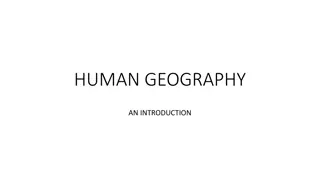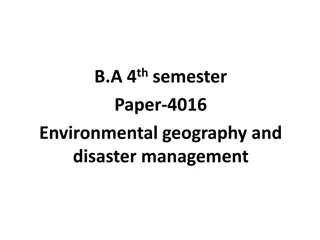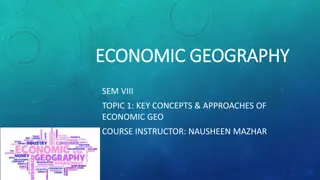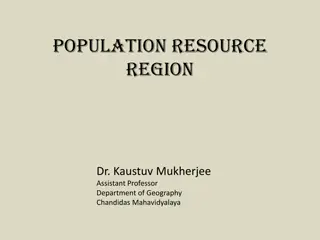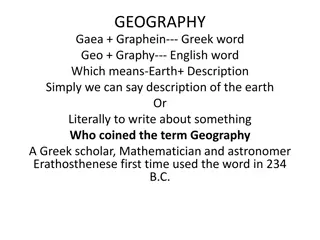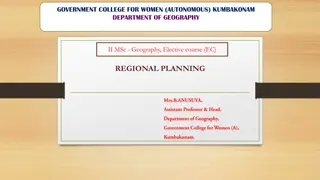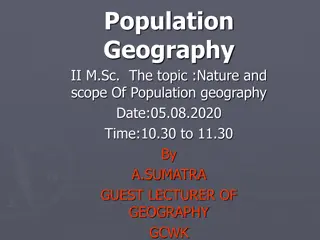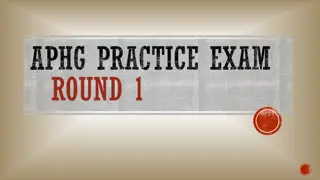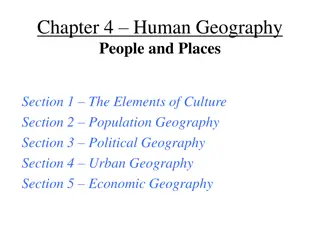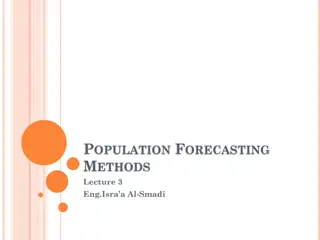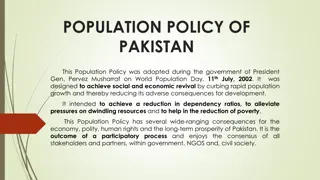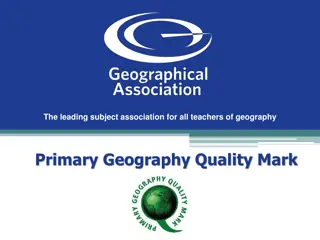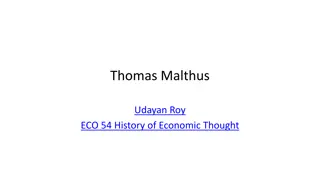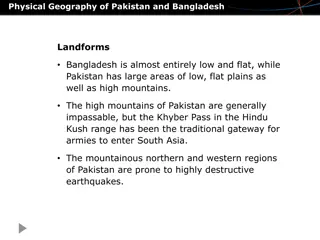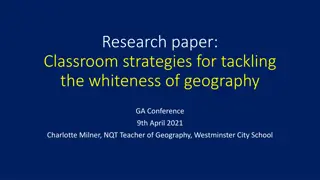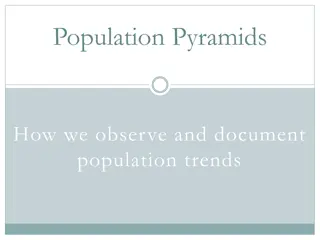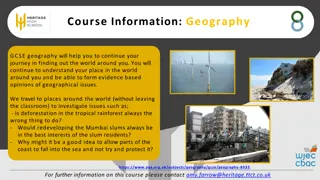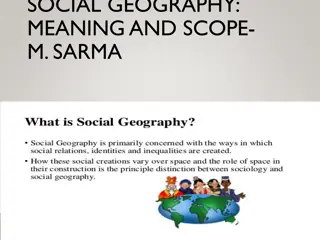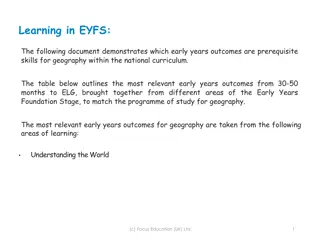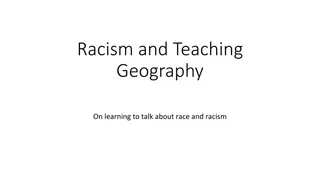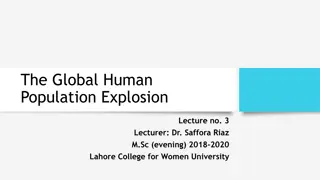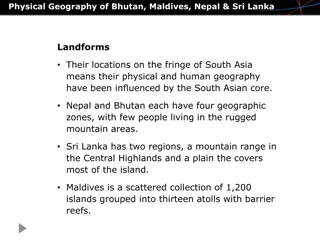Introduction to Geography
Explore the intricate relationship between language, culture, and geography in Chapter 7 of "Introduction to Geography: People, Places, and Environment." Delve into the significance of languages, dialects, and religions as defining factors of human cultures, along with the role of language developme
2 views • 63 slides
Durham University Geography Department Overview
Durham University's Geography Department, led by Professor Cheryl McEwan, offers world-leading research and teaching. With a strong support network for students, including first-generation scholars, the department provides a range of undergraduate courses in both Human and Physical Geography. Studen
0 views • 5 slides
Overview of the South African National Population Register
The South African National Population Register (NPR) is a vital system maintained by the Department of Home Affairs. It serves to record and update information on the country's resident population, issue identity documents, and handle related administrative tasks. The NPR has evolved over the years
2 views • 16 slides
Articulating the usefulness of geography in the real world.
Explore the evolving landscape of geography education through insightful data on student enrollment trends, subject choice theories, and barriers faced in teaching geography. Delve into how educators can leverage subject choice theory to enhance the options process and address student interest in bo
3 views • 29 slides
HUMAN GEOGRAPHY
Human geography examines how human groups adapt to their natural environment. It covers various branches such as social, economic, population, historical, political, and military geography. The discipline also explores fundamental principles and theories like environmental determinism, possibilism,
2 views • 6 slides
Impact of Human Population Growth on Environment and Welfare
The rapid growth of the human population is placing immense pressure on the environment, leading to increased demand for resources like food, water, and shelter. The effects of human activity on the environment have escalated significantly over the years due to population expansion. High birth rates
1 views • 8 slides
Geography at Ramsey Grammar School: Course Insights, Student Feedback, and Achievements
Discover the engaging Geography course at Ramsey Grammar School Year 9, where students find the subject enjoyable, relatable, and enriching. The department's success in nurturing skills and understanding is evident from the high achievement rates. Geography offers a diverse curriculum linking to var
1 views • 19 slides
Environmental Geography and Disaster Management in B.A. 4th Semester - Paper 4016
Environmental geography encompasses the systematic study of the interactions between living organisms and their natural surroundings, focusing on spatial attributes and human-nature relationships. This branch of geography emphasizes the application of geographical information to address environmenta
1 views • 6 slides
Key Concepts in Economic Geography
Economic Geography is a sub-discipline that utilizes a geographical approach to analyze the spatial distribution of economic activities at various scales. It focuses on the location of economic activities and their relationship with the environment, encompassing primary, secondary, and tertiary sect
2 views • 20 slides
Introduction to Sampling in Statistics
Sampling in statistics involves selecting a subset of individuals from a population to gather information, as it is often impractical to study the entire population. This method helps in estimating population characteristics, although it comes with inherent sampling errors. Parameters represent popu
2 views • 24 slides
Population-Resource-Region Relationship: A Geographical Perspective
Explore the intricate relationship between population, resources, and regions through a geographical lens. Delve into classifications based on population, resources, and technology, with examples from different countries and regions. Discover the concepts of optimum population, over-population, and
2 views • 11 slides
Geography: Earth's Description and Study
Geography, coined by Greek scholar Eratosthenes, encompasses the description and explanation of Earth's surface differentiation. It involves physical and human aspects, with branches like geomorphology, climatology, and economic geography. Physical geography studies the lithosphere, atmosphere, hydr
0 views • 6 slides
Geographical Space in Geography Studies
Geographical space in geography encompasses natural and social elements, defining locations, and interactions essential for comprehending the world. Space and place influence various aspects such as economics, health, and climate. Geographers explore spatial distribution, processes, and human-enviro
0 views • 20 slides
Demography: Population Trends and Analysis
Demography is the study of population size, distribution, and composition, encompassing elements such as mortality, natality, migration, and demographic forces. Population census plays a crucial role in collecting and analyzing demographic data, with methods like De Jure and De Facto census. Inter-c
6 views • 21 slides
Population Geography: Nature and Scope
Population geography explores how spatial variations in population distribution, composition, migration, and growth are connected to geographic features. It focuses on the interplay between human societies, the physical environment, and cultural aspects. Factors influencing population distribution i
1 views • 13 slides
Comparing 1750 to 1900: Population Growth in Britain
The population of Britain saw a significant increase between 1750 and 1900. In 1750, the population was 7 million, and by 1900, it had grown to 37 million. This represented an 87% increase. The number of people living in towns also rose from 13% to a higher percentage. Factors contributing to this g
0 views • 6 slides
Geography Practice Exam Round 1 Questions
Practice your AP Human Geography knowledge with these multiple-choice questions covering topics such as demographic indicators, cultural diffusion, population growth, cultural landscapes, and urban land use patterns. Test your understanding of concepts like fertility rates, diffusion types, populati
1 views • 106 slides
Population Resource Regions and Zelinsky's Classification
Geographers have long studied the relationship between population growth and resource adequacy, leading to the concept of Population Resource Regions (PRR) by W. Zelinsky. Zelinsky identified five types of PRR based on population-resource ratios, ranging from Type A with high resource utilization po
0 views • 8 slides
Population Distribution in Different Regions of Pakistan
The population distribution in Pakistan varies significantly among different regions, with certain provinces like Punjab and Sindh having higher population densities compared to Baluchistan and FATA. The rural areas are also categorized into different population density regions based on the number o
0 views • 14 slides
Human Geography: Culture, Population, and Places
Delve into the diverse elements of human geography, from the intricacies of culture including food, religion, and language to the dynamics of population geography like natural increase rates and population density. Gain insights into political, urban, and economic geography as you discover where the
0 views • 39 slides
Methods of Population Forecasting for Urban Development
Designing water supply and sanitation schemes for cities requires accurate population forecasting. Factors influencing population changes include births, deaths, migration, and annexation. Various methods like Arithmetic Increase, Geometric Increase, and Ratio Method are used to predict population g
4 views • 24 slides
Population Policy of Pakistan: Vision, Goals, and Strategies
The Population Policy of Pakistan, adopted in 2002, aims to stabilize the population by 2020 through a focus on reducing fertility rates and promoting family planning. The policy outlines goals such as achieving a balance between resources and population, increasing awareness of rapid population gro
0 views • 11 slides
Enhancing Geography Education with the Primary Geography Quality Mark
The Primary Geography Quality Mark (PGQM) plays a crucial role in enhancing standards in geographical learning for schools. By providing a powerful process of self-evaluation and reflection, the PGQM aims to engage, stimulate, and support teachers in improving curriculum planning, CPD, and overall d
0 views • 15 slides
Thomas Malthus and His Theory on Population Growth
Thomas Robert Malthus, an influential economist, proposed a theory on population growth in the 18th century. His theory suggested that population grows exponentially while food production increases at a slower rate, leading to inevitable food scarcity. Malthus also discussed the concept of preventiv
2 views • 19 slides
Improvement of Population and Vital Statistics Metadata in the Demographic Yearbook System
The Demographic Yearbook system focuses on enhancing population and vital statistics metadata to ensure accurate and concise reflection of population concepts across 230+ countries. It involves annual collection of official national population estimates, vital statistics, and UN international travel
0 views • 16 slides
Geography Homework: Exploring the Middle East in Year 8
Explore the captivating world region of the Middle East in this Year 8 geography homework booklet. From matching capitals to countries and understanding the importance of diversification, to delving into the physical geography, climate, and population changes of the region, this booklet offers a com
0 views • 15 slides
Discover the Fascinating World of Geography - GCSE Overview
Explore the diverse field of Geography through this GCSE overview. Delve into Physical Geography encompassing natural elements like climate and landforms, and Human Geography focusing on human interactions with the planet. Uncover the unique blend of transferable skills such as communication, teamwo
0 views • 30 slides
Geography and Society of Pakistan and Bangladesh
Physical geography of Pakistan features low plains and high mountains, while Bangladesh is predominantly flat. The water systems in both countries play a crucial role, with rivers like the Ganges providing water resources. The climates vary between the tropical wet climate of Bangladesh and the dry
0 views • 10 slides
Addressing Whiteness in Geography Education: Classroom Strategies
This research paper explores the persistence of whiteness in the field of geography education, addressing systemic racism and lack of diversity in knowledge production. The study highlights classroom strategies for tackling issues such as country representation and alienation of students based on he
0 views • 18 slides
Physical Geography: Branches and Concepts Explored
Physical geography is a field that studies natural processes on Earth's surface, providing the backdrop for human activities. It encompasses various branches like geomorphology, climatology, oceanography, biogeography, soil geography, and environmental geography. Geomorphology investigates landforms
0 views • 10 slides
Logistic Growth in Population Dynamics
Explore the logistic growth equation and its applications in modeling population dynamics. Dive into the concept of sigmoidal growth curves and the logistic model, which reflects population growth with limits. Learn how to calculate population change using the logistic growth equation and understand
1 views • 26 slides
Overview of Population Measures and District Data from Census Reports
The census reports various population measures including total population, voting age population, and citizen voting age population. The data includes breakdowns by ethnicity for each trustee district. Changes in voting and citizen voting age population percentages are also provided. Data is sourced
1 views • 4 slides
Population Pyramids for Analyzing Population Trends
Population pyramids are graphical illustrations that showcase the distribution of age groups within a population, segmented by gender. By observing and documenting the patterns of population pyramids, one can discern trends such as rapid growth, slow growth, or negative growth, which are influenced
0 views • 7 slides
Geography: GCSE Course Overview, Assessment & Beyond
Dive into the GCSE Geography course to gain a deeper understanding of the world around you. Explore topics such as deforestation, urban development, and coastal erosion. The course assesses your knowledge through papers on natural hazards, societal issues, and geographical exploration. Discover care
0 views • 4 slides
Social Geography: Meaning, Scope, and Differences
Social geography is a branch of human geography focusing on social structures, groups, and activities. It examines the spatial arrangement of social phenomena, social differences, and patterns in understanding socially defined population groups. The scope of social geography includes analyzing spati
0 views • 25 slides
Early Years Outcomes Prerequisite Skills for Geography in National Curriculum
The document outlines early years outcomes crucial for geography in the national curriculum, spanning from 30-50 months to ELG. It highlights skills like observing, questioning, understanding growth, showing care, recognizing similarities and differences, and more in young learners, preparing them f
0 views • 10 slides
Intersection of Racism and Geography Education
The content delves into the presence of structural racism in society, particularly within the education system and geography curriculum. It emphasizes the importance of addressing racism within educational institutions, urging for action rather than mere declarations of inclusivity. The discussion h
0 views • 7 slides
Maine Workforce and Population Trends Analysis 2014-2024
Maine's workforce and population outlook from 2014 to 2024 reveals a decline in births, resulting in an aging population and workforce imbalance. The state faces challenges due to low birth rates, negative natural population change, and minimal net migration, impacting labor force growth and total p
0 views • 31 slides
The Global Human Population Explosion: Causes and Implications
The lecture explores the rapid increase in the global human population post-World War II, analyzing factors such as birth rates, mortality rates, and life expectancy. Various counterarguments are presented, including the debate on population growth benefits, ethical concerns over reproductive interf
0 views • 20 slides
Physical Geography & Human Geography Influence in Bhutan, Maldives, Nepal & Sri Lanka
The physical & human geography of Bhutan, Maldives, Nepal, & Sri Lanka have been shaped by their locations on the fringes of South Asia. Explore their landforms, water systems, climates, resources, history, government, population patterns, society & culture.
0 views • 10 slides




